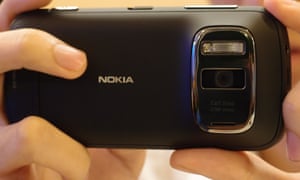Which smartphone has the best camera?
Jack Schofield
Alison needs to replace her smartphone and she wants one that will take good photographs in a wide range of lighting conditions.
Continuing the theme from last week, I need advice on replacing my Huawei smartphone, following an unfortunate incident involving a car door. My phone is also my camera, so my main criterion is that it will take good shots in most lights. The Huawei, while fine in other ways, fell short in the photography department. I’d be interested in recommendations at different price points. Alison
Smartphone cameras are now amazingly good, and if you buy a top-end smartphone, it’s increasingly hard to take a bad photograph with it. We’ve therefore started to see some Darwinian-style speciation as manufacturers look for profitable niches. Over the past five years, we’ve seen more dual-lens cameras appear with extra wide angle or telephoto features. Some manufacturers have improved the front-facing camera to target people who mainly take selfies. Some phones are waterproof, like the Apple iPhone 7 and the Samsung Galaxy S7.
Some manufacturers have added 4K video facilities. Many offer HDR for high dynamic range images, and some use “stacking”, such as the Google Pixel (it captures a short sequence and combines the results into a single image). Some have dual lenses and dual sensors and combine the results, like the LG G6. Some phones shoot 4K video or raw images, possibly by using accessory software to extract the image data before it has been processed.
As a result, the best smartphone camera for one user may not be the best for another. You will have to think about what you want to shoot, and pick the smartphone that best meets your needs.
Of course, if you buy a mid-range or low-end smartphone, you won’t get many special features, and the general quality will be lower. In my (limited) experience, however, most cheap smartphones take perfectly good pictures in good lighting conditions. It’s only in low light that images tend to look grainy, because of image noise.
Image v reality
The main technical difference between smartphone cameras and standalone digital cameras is that smartphones use tiny lenses and tiny sensors. The smartphone’s results ought to be much worse. They are not. Smartphones produce high-quality results by using their powerful processors and built-in graphics engines to process the image data and compensate for their technical limitations.
To my eye, smartphone images are sometimes so over-saturated and over-sharpened they look unnatural. In some cases, where portraits are “beautified”, they really are unnatural. However, very few people are interested in how the final image compares to the reality. They’d much rather have something that looks good. Exaggeration wins almost every time.
However, this does mean there’s an element of taste when choosing a smartphone camera. When you have a shortlist, look for sample images in reviews at websites such as DxO Mark, The Verge and DP Review, and on Flickr’s Camera Finder.
Also, see if you can get friends to take photos of a colourful object that’s small enough for you to carry around, such as a trinket box, to provide comparisons. You may not be planning to buy that particular model, but different smartphones from the same manufacturer may use the same sensors (often from Sony) and the same processing software, giving the results a family resemblance.
Possible options
The Nokia 808 PureView smartphone, launched in 2012, really boosted progress in smartphone photography. Its 38-megapixel sensor captured an amazing amount of detail, and changed the perception of how good a smartphone camera could be. The 808 and its Windows smartphone cousin, the Lumia 1020, are still competitive today, though they have been surpassed by more recent models.
Today’s better smartphone cameras typically have f/1.8 lenses and 12MP 1/3in sensors providing a resolution of 4032 x 3024 pixels. That’s the specification of Apple’s iPhone 7, so try to match or beat that. The Google Pixel – which may have the best smartphone camera – has a slightly bigger 12.3MP 1/2.3in sensor and an f/2.0 lens.

The smaller the number, the better. A 1/2.5in sensor is bigger and less noisy than a 1/3in sensor, while an f/1.7 lens is faster (gathers more light) than an f/2 lens. When it comes to megapixels, the more the better. However, anything over 10MP is fine, unless you want to make large prints.
The Verge has an excellent group review of four of the main options: the four main options are the Samsung Galaxy S8, Apple’s iPhone 7, Google Pixel and LG’s G6. Take your pick. Also worth a mention are the iPhone 7 Plus and the new HTC U11, which is out in June.
If you want something cheaper, the OnePlus 3T has a 16MP 1/2.8in sensor and an f/2.0 lens. DP Review reckons it is “not quite up with the very best in class” but it’s still very good, and the OnePlus 5 should be even better. (OnePlus is owned by Oppo, the giant Chinese smartphone manufacturer.)
In the budget department, Lenovo’s £159 Moto G5 has a 13MP 1/2.5in sensor and an f/2.0 lens, while the £249 G5 Plus is a 12MP camera with a faster f/1.7 lens. Both offer auto HDR and have “professional” and “beautification” modes. The pro mode gives you manual control.
I can’t think of anything that’s likely to beat the G5 at the price, though readers may have some suggestions in the comments below.
DxO Marks
If you follow smartphone cameras, you will run into DxO Marks. DxO Labs sells a small camera and various photo-enhancement programs such as DxO OpticsPro. It has been testing still cameras and lenses for years, and in 2012 it introduced the DxO Mark Mobile rating system. Basically, it tests smartphone camera systems and gives them a score. The result is a table with the best at the top.
This makes life easy for journalists, who can write articles about the latest smartphone to top the list. How much it actually means is debatable: is the HTC U11 (90 points) really better than the Google Pixel (89) or the Galaxy S8 (88)? Nonetheless, whatever made the top 20 or 25 is generally better than whatever didn’t.
If DxO Labs has tested a smartphone you want to buy, the reviews are useful. Unfortunately, it hasn’t reviewed the OnePlus T3 or the Moto G5. However, the Moto Z Force Droid (87) and the Moto G Plus (84) scored well. They did better than the iPhone 6 Plus (82), Huawei P9 (80), my Google Nexus 6 (78) and the Lumia 1020 (74).
Camera first
A few companies have tried putting the camera before the phone. The best known example is the Lumix DMC-CM1, which has a 20MP one inch sensor (roughly 7x larger than a 1/3in sensor) and an f/2.8 Leica lens. Panasonic calls it a “communication camera”.
Samsung has also had a couple of goes at the genre with its Samsung Galaxy K Zoom and older S4 Zoom smartphones. Both have 10x optical zoom lenses, much like compact cameras. The most recent example is the 21MP Kodak Ektra, which was launched in Europe last year and in the US this week. I’ve not seen or tried one, but it looks a bit pricey at £449.
However, if you’re serious about the photographic aspect, consider buying a good compact camera and a cheap phone. Not only do you get better results over a wider range of subjects and situations, the camera handling is dramatically better. This includes faster zooming, framing and shooting.
There are a few good compact cameras with one inch sensors, including the tiny but pricey Sony RX100V, several Canon PowerShots (from the G3 X to the G9 X), the Lumix DMC-LX10 and even the DxO One. I usually carry a compact that fits in a jeans pocket when I’m not lugging around a Nikon D90 with a couple of lenses. A good camera could well outlast several smartphones.
Source: theguardian.com










